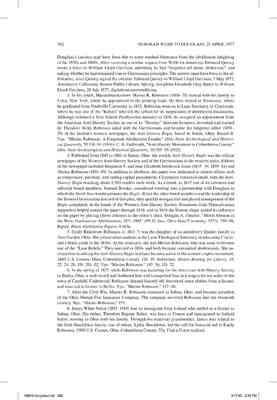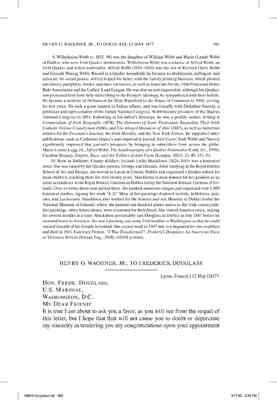Pages
page_0001
DEBORAH WEBB1Deborah Webb (1837–1921) was the daughter of Richard and Hannah Webb. Growing up in a staunchly Quaker and abolitionist household, Deborah supported the antislavery cause and aligned herself with the Garrisonians. She wrote antislavery poetry, and Evelyn Noble Armitage (writing in 1896) attributed “John Brown’s March” to her pen. In this poem, Deborah wrote new lyrics for the popular song “John Brown’s Body,” signaling her support for the Union and for abolition. According to Armitage, Deborah wrote that her family home in Dublin was “a resort of various celebrities and philanthropists, particularly of abolitionists and escaped slaves.” She visited the United States after the Civil War with her father and met abolitionists such as William Lloyd Garrison and Lucretia Mott. Deborah married the grandson of James Hargreaves (who created the spinning jenny in 1764); she is buried in the Friends Burial Grounds Cemetery in County Dublin, Ireland. Evelyn Noble Armitage, The Quaker Poets of Great Britain and Ireland (London, 1896), 289; Richard S. Harrison, Richard Davis Webb: Dublin Quaker Printer (Skeagh, Ire., 1993); Merrill and Ruchames, Garrison Letters, 6: 56. TO FREDERICK DOUGLASS
Rathgar, Dublin[, Ire.] 21 April 1877.
DEAR SIR,
Will you kindly look at enclosed circuler. I hope it may recommend itself to your sympathy. We should feel our list to be incomplete without your name—The amount contributed is of less importence.2It appears Douglass did not sign this circular (for reasons unknown), because when Marius Robinson sent out his own letter thanking contributors, Douglass’s name does not appear in it. Douglass’s inaction may have been due to some residual bitterness from the abolitionist infighting of the 1850s and 1860s. After receiving a similar request from Webb for donations, Edmund Quincy wrote a letter to William Lloyd Garrison, admitting he had “forgotten all about [Robinson]” and asking whether he had remained true to Garrisonian principles. The answer must have been in the affirmative, since Quincy signed the circular. Edmund Quincy to William Lloyd Garrison, 7 May 1877, Antislavery Collection, Boston Public Library, bpl.org; Josephine Elizabeth Grey Butler to William Lloyd Garrison, 28 July 1877, digitalcommonwealth.org. We think the testimonial will be graceful & appropriate and certainly a little help is really needed—although Mr. Robinson3In his youth, Massachusetts-born Marius R. Robinson (1806–78) moved with his family to Utica, New York, where he apprenticed in the printing trade. He then moved to Tennessee, where he graduated from Nashville University in 1832. Robinson went on to Lane Seminary in Cincinnati, where he was one of the “Rebels” who left the school for its suppression of abolitionist discussions. Although ordained a New School Presbyterian minister in 1836, he accepted an appointment from the American Anti-Slavery Society as one of its “Seventy” itinerant lecturers, recruited and trained by Theodore Weld. Robinson sided with the Garrisonians and became the longtime editor (1851–59) of the faction’s western newspaper, the Anti-Slavery Bugle, based in Salem, Ohio. Russel B. Nye, “Marius Robinson: A Forgotten Abolitionist Leader,” Ohio State Archeological and Historical Quarterly, 55: 138–54 (1946); C. B. Galbreath, “Anti-Slavery Movement in Columbiana County,” Ohio State Archeological and Historical Quarterly, 30: 355–95 (1921). would be the last man to say so.
Yours respectfully, with recollections of old times in Ireland.
DEBORAH WEBB
[P.S.] Perhaps you will obligingly mention the matter to anyone in Washington likely to be interested and willing to help one of your most zealous fellow-workers.
PRIVATE.
Marius R. Robinson, of Salem, Ohio, formerly editor of The Anti-Slavery Bugle,4Published from 1845 to 1861 in Salem, Ohio, the weekly Anti-Slavery Bugle was the official newspaper of the Western Anti-Slavery Society and of the Garrisonians in the western states. Editors of the newspaper included Benjamin S. and Jane Elizabeth Hitchcock Jones (1845–49, 1859–61) and Marius Robinson (1851–59). In addition to abolition, the paper was dedicated to reform efforts such as temperance, pacifism, and ending capital punishment. Circulation remained small, with the Anti-Slavery Bugle reaching about 1,500 readers each week. As a result, in 1847 one of its investors and editorial board members, Samuel Brooke, considered entering into a partnership with Douglass in which the North Star would subsume the Bugle. When the other board members and the leadership of the Boston Garrisonians learned of this plan, they quickly reorganized and placed management of the Bugle completely in the hands of the Western Anti-Slavery Society. Donations from Pennsylvanian supporters helped sustain the paper through 1848, and in 1849 the Boston clique sealed its influence on the paper by placing Oliver Johnson in the editor’s chair. Douglas A. Gamble, “Moral Suasion in the West: Garrisonian Abolitionism, 1831–1861” (Ph.D. diss., Ohio State University, 1973), 350–56; Ripley, Black Abolitionist Papers, 4: 185n. was, with his equally devoted wife,5Emily Rakestraw Robinson (c. 1811–?) was the daughter of an antislavery Quaker family in New Garden, Ohio. She joined other students at the Lane Theological Seminary in educating Cincinnati’s black youth in the 1830s. At the seminary, she met Marius Robinson, who was soon to become one of the “Lane Rebels.” They married in 1836, and both became committed abolitionists. She assisted him in editing the Anti-Slavery Bugle and later became active in the women’s rights movement. 1860 U.S. Census, Ohio, Columbiana County, 116–19; Robertson, Hearts Beating for Liberty, 15, 22–24, 28, 191, 201–02; Nye, “Marius Robinson,” 145–36, 151–52. among the earliest and most faithful Abolitionists. On one occasion he was tarred and feathered, from the shock of which his delicate constitution has never recovered.6In the spring of 1837, while Robinson was lecturing for the American Anti-Slavery Society in Berlin, Ohio, a mob tarred and feathered him and transported him in a wagon for ten miles to the town of Canfield. Undeterred, Robinson cleaned himself off, borrowed some clothes from a farmer, and returned to lecture in Berlin. Nye, “Marius Robinson,” 147–48. He has lately, through the failure of an Insurance Company, lost the prospect of a small independence for himself and his wife in age and declining health.7After the Civil War, Marius R. Robinson remained in Salem, Ohio, and became president of the Ohio Mutual Fire Insurance Company. The company survived Robinson into the twentieth century. Nye, “Marius Robinson,” 153. We propose that Mr. Robinson should be presented with a pecuniary testimonial on his 72nd birthday—the 2nd of July. Those who have had the pleasure of his personal acquaintance will probably feel it a further
page_0002
privilege to be able to give him a substantial proof of sympathy and respect.
We shall be glad of the co-operation of anyone who likes to join us. It is important to keep the matter strictly private. The gift is intended as a pleasant surprise in a time of difficulty and anxiety. The amount contributed by each must depend on means and inclination. The presentation might be accompanied with some such words as the following:—
“Dear Sir,
“A few of your friends and well-wishers, and in some cases fellowworkers in the Anti-Slavery Cause, for which you and Mrs. Robinson so generously laboured, request your acceptance of a little testimonial of esteem, with their congratulations on your birthday.”
[Here might follow the names, alphabetically arranged.]
It would be well for each contributor to enclose his or her name and address on one of the slips of gummed paper enclosed, for placing under the letter of presentation. A report of result of this circular will be sent to each contributor.
James W. Suliot,8James White Suliot (1833–1914) was an immigrant from Ireland who settled as a farmer in Salem, Ohio. His father, Theodore Eugene Suliot, was born in France and immigrated to Ireland before moving to Ohio with his family. Through his maternal grandmother, James was related to the Irish Shackleton family, one of whom, Lydia Shackleton, led the call for financial aid to Emily Robinson. 1900 U.S. Census, Ohio, Columbiana County, 35a; Find a Grave (online). of Salem, Columbiana County, Ohio, has kindly consented to receive contributions in America.
Those on this side may be sent to Alfred Webb,9Wilhelmina Webb (c. 1832–98) was the daughter of William Webb and Maria (Lamb) Webb of Dublin, who were Irish Quaker abolitionists. Wilhelmina Webb was a relative of Alfred Webb, an Irish Quaker and ardent nationalist. Alfred Webb (1834–1908) was the son of Richard Davis Webb and Hannah Waring Webb. Raised in a Quaker household, he became an abolitionist, suffragist, and advocate for social justice. Alfred helped his father with the family printing business, which printed antislavery pamphlets, books, and slave narratives, as well as materials for the Irish Protestant Home Rule Association and the Ladies’ Land League. He was also an anti-imperialist: although his Quakerism prevented him from fully subscribing to the Fenians’ ideology, he sympathized with their beliefs. He became a member of Parliament for West Waterford in the House of Commons in 1890, serving for five years. He took a great interest in Indian affairs, and was friendly with Dadabhai Naoroji, a politician and representative of the Indian National Congress. Webb became president of the Madras National Congress in 1894. Following in his father’s footsteps, he was a prolific author, writing A Compendium of Irish Biography (1878), The Opinions of Some Protestants Regarding Their Irish Catholic Fellow-Countrymen (1886), and The Alleged Massacre of 1641 (1887), as well as numerous articles for the Freeman’s Journal, the Irish Monthly, and the New York Nation. He supported other publications, such as Catherine Impey’s anti-imperialist journal Anti-Caste; both Webb and Naoroji significantly improved that journal’s prospects by bringing in subscribers from across the globe. Marie-Louise Legg, ed., Alfred Webb: The Autobiography of a Quaker Nationalist (Cork, Ire., 1999); Caroline Bressey, Empire, Race, and the Politics of Anti-Caste (London, 2013), 23, 89, 153–54. Highfield-road, Rathgar, Dublin.
Contributions should, if possible, be forwarded immediately.
LYDIA SHACKLETON10Born in Ballitore, County Kildare, Ireland, Lydia Shackleton (1828–1914) was a botanical artist. She was raised by her Quaker parents, George and Hannah. After studying at the Royal Dublin School of Art and Design, she moved to Lucan in County Dublin and organized a Quaker school for local children, teaching there for over twenty years. Shackleton is most famous for her position as an artist in residence at the Royal Botanic Gardens in Dublin (today the National Botanic Gardens of Ireland). Over a twenty-three-year period there, she painted numerous images and organized over 1,500 botanical studies, signing her work “L.S.” Most of her paintings depicted orchids, hellebores, peonies, and Lachnealia. Shackleton also worked for the Science and Art Museum in Dublin (today the National Museum of Ireland), where she painted one hundred plants native to the Irish countryside. Her paintings, often watercolours, were renowned for their detail. She visited America twice, staying for several months at a time. Shackleton presumably met Douglass in Dublin in July 1887 before he returned home to America; she sent a painting and some Irish heather to Washington so that he could remind himself of his friends in Ireland. She ceased work in 1907 due to a degenerative eye condition and died in 1914. Laurence Fenton, “I Was Transformed”: Frederick Douglass; An American Slave in Victorian Britain (Stroud, Eng., 2018); ODNB (online).
DEBORAH WEBB
Dublin, Ireland 3 April, 1877.
Enclose D Webb. to F. Douglass
ALS: General Correspondence File, reel 3, frames 115–16, FD Papers, DLC.



